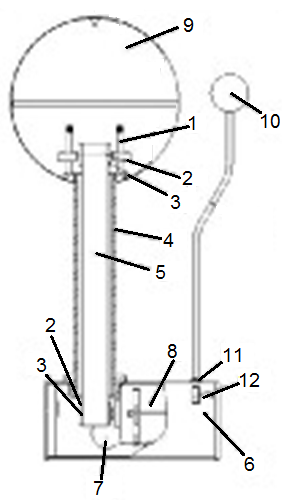
Van De Graaff Generator
1.Belt tension adjusting screw
2.Collecting comb
3.Roller
4.Rubber belt
5.Plastic support tube
6.Bottom bracing
7.Light bulb
8.Electric motor
9.Electrode ball
10.Discharge wand
11.Grounding socket
12.Power switch
Features
Perfect apparatus for demonstrations
Affordable price
Includes accessories
Introduction
The Van De Graaff Generator is a type of electrostatic high-voltage generator designed to accumulate large amounts of electric potential on a hollow metal globe. The generator operates using a moving belt to transfer electric charge to the metal sphere, enabling it to reach high-voltage levels. It serves as a fundamental tool in demonstrating various electrostatic phenomena and provides a high-voltage source that is widely used in physics education.
The Van De Graaff Generator can be used to demonstrate a variety of fundamental electrostatic concepts and phenomena:
- Charge Nature: Demonstrate the behavior of electric charges and how like charges repel while opposite charges attract. The generator allows students to observe how charges accumulate and interact on the globe and other objects.
- Electric Field Lines: Use the generator to visualize lines of electric force and electric field patterns. The high-voltage discharge provides a clear way to understand electric fields around conductors.
- Spark Discharge: Show the spectacular effects of high-voltage spark discharge, where the generator can produce visible electric arcs. This can also be used to explain how electric breakdown occurs in air and how high-voltage systems work.
- Parallel Plate Capacitor: Demonstrate how a parallel plate capacitor works and how the voltage across a capacitor changes when subjected to high-voltage charges. The Van De Graaff generator can be used to charge capacitors and show how electric potential accumulates between two plates.
- Electrostatic Precipitation: Use the generator to demonstrate the principle of electrostatic precipitation, where charged particles are attracted to oppositely charged surfaces, mimicking how dust or smoke particles are removed from the air using electrostatic precipitators.
By using the Van De Graaff Generator, students will be able to:
1. Understand Electrostatic Charge and Force: Observe how electric charges are accumulated and how the force between charges behaves. Understand the effects of similar and opposite charges and how they influence each other.
2. Visualize Electric Fields: Explore the electric field patterns produced by high-voltage charges on the globe, and study how these fields interact with nearby conductors and other charged objects.
3. Experience Spark Discharge: Witness the power of spark discharges and understand the physics behind the breakdown of air at high voltages, which allows for the visible electric arcs.
4. Explore Capacitors and Electrostatic Precipitation: Gain practical insights into the working principles of capacitors and electrostatic precipitators by using the generator to demonstrate charge accumulation and removal of particles.
Specifications
| Description | Specifications |
| Diameter of electrode ball | 250 mm |
| Diameter of discharge ball | 60 mm |
| Power consumption | approximately 40 W |
| Distance of spark discharge | ≥ 60 mm |
Parts List
| Description | Qty |
| Main Unit | 1 |
| Discharge Wand | 1 |
| Faraday's Pail | 1 |
| Perspex Cylinder with Conductive Spheres | 1 |
| Flying Ball Hung from Plastic Rod | 1 |
| Bundle of Artificial Hair | 1 |
| Replacement Belt | 1 |
| Grounding Cable | 1 |
| Instructional Manual | 1 |
Safety Warning
People with pacemakers or heart conditions should not approach to this apparatus within 15 feet when the apparatus is running. As otherwise, the apparatus could disrupt the proper operation of pacemakers causing serious injury or death to those with heart conditions.

Van De Graaff Generator
1.Belt tension adjusting screw
2.Collecting comb
3.Roller
4.Rubber belt
5.Plastic support tube
6.Bottom bracing
7.Light bulb
8.Electric motor
9.Electrode ball
10.Discharge wand
11.Grounding socket
12.Power switch